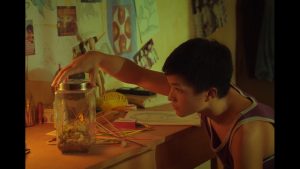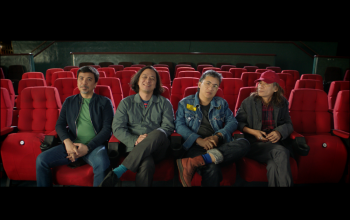Metamorphosis review: Engelbert Rafferty dissects J.E. Tiglao’s debut film, nearly an out-of-body experience as it is.
Gender has been the forefront of multitudes of debates sparking from controversies created by our predominantly heterosexual society. Religious beliefs, personal experiences, cultural upbringings and social environments, among many others, are brought into the equation as the stratification and deviation of gender roles and classes come into full circle in our society, trying to venture into the cosmos for the possession of equality. Despite not being within reach yet, the possession is narrowed significantly. Anne Fausto-Sterling once wrote about the role of gender in our society in her book called Sexing the Body, wherein she said “our bodies are too complex to provide clear-cut answers about sexual difference. The more we look for a simple physical basis for ‘sex,’ the more it becomes clear that ‘sex’ is not a pure physical category. What bodily signals and functions we define as male or female come already entangled in our ideas about gender.”
Gender roles are among the issues society continues to define–laid bare to the masses are occupational differences, ideological agendas, class formation and universal acceptance. Women, who were once looked down upon for not having the same intellect and strength that men have, are now in the same level as men in terms of employment and societal roles. LGBT communities roam freely in voicing out their opinions on matters that leave a lasting impact to our government and to our everyday lives. As the LGBT strand grows bigger, information and knowledge pertinent to gender and sex have become relevant and timely in our educational system as people discover that there is more to gender than just homos and heteros. A particular example of this information that many people to this date may still not havea genuine erudition of is that of the intersex. One may know an intersex generally as having an atypical definition of their physical bodies, one that cannot instantaneously classify as “male” or “female.” A more derogatory term used by many to define their nature is hermaphrodite, which is a living being who has both male and female genitalia. Little do we have access to their stories and little do we have information about the hardships they have encountered in their society.
In Jose Enrique Tiglao’s debut full-length after two short films from Cinemalaya, the story of an intersex is revealed. Metamorphosis observes the periodic development of an intersex set in a milieu with minimal access to information as the identity and existence becomes unclear to the mind of the lead and the implicit necessity to belong in a certain strand in the society suffocates the mind of an individual perplexed by the truth regarding himself (or herself).
Adam (Gold Azeron) lives in a devout Christian household with his mother Elena (Yayo Aguila) and his father Edgar (Ricky Davao), who happens to be a renowned pastor in their neighborhood for conducting a number of praise and worship sessions at their front yard. Despite such an upbringing, Adam dabbles on typical schoolboy mischief, butting heads almost every day with his equally rambunctious classmate whom he had derogatorily labeled as Supot (Dylan Ray Talon). In the middle of the school year, a newcomer from their high school, Angel (Iana Bernadez), becomes his object of desire. The two form an intimate relationship through the simplest of things–making school projects, going home from school every day and exploring the community and all the beautiful scenery found in it. On an unexpected day, Adam discovers himself having two genitalia when he sees himself having a period. With the dawn of such discovery, he finds himself warring through his identity and gender, unwary of the truth lurking behind his whole being, and eventually comes of age.
The biggest question surfacing the creation of such a film, one that tackles a theme with extremely sensitive content and information, is whether or not the film should be handled through a more conventional form of storytelling. Having insufficient bases on the conception of the film’s possible direction, Tiglao has been given more freedom to express the realities of an intersex’s struggle and how the discovery of their true nature impacts their families, their loved ones and the people around them. The history behind the film, after all, is pervaded with controversy (plagiarism, wherein the film’s teaser poster way back 2016 when the film was supposed to be a main competition entry of Cinemalaya that year was apparently owned by artist Chiara Aime; intellectual property, wherein the film’s previous title Maselang Bahaghari is coincidentally the title of a song made by Filipino band Eraserheads; censorship, wherein the film was rated X by the Philippine’s media classification board during the board’s first viewing of the film). Controversies aside, Tiglao gave respect to the sensitive content given into his hands and has created a tribute to the intersex community by conveying a story so earnest and honest, supported by a prismatic cinematography work by Tey Clamor (who has worked on some of the most beautifully shot films this year, like Babae at Baril and Isa Pa, with Feelings), using colors and aspect ratios to showcase the beauty of Adam and divine musical score by Divino Dacunas, giving an atmospheric vibe to Adam’s experience as he “comes of age.”
While the film can be incriminated for being formulaic, melodramatic and on-the-nose in depicting Adam’s story of sexual awakening, the film lays bare its heart by showing Adam’s physiological and psychological development as the discovery of his gender pits him to making a decision. As the universe somehow dictates everything that he should do, from undergoing surgery to escaping a newly-discovered part of his being, he walks through life with a mask of indifference, uncertain of what both the present and the future will bring him. Gold Azeron carries the mask with nary a sliver of hesitation. Azeron conveys his character as though he himself has lived through the struggles of an intersex; never did he show any sort of hesitation in carrying the role through the weight of his shoulders and while this is only his second film, after 2016’s Lando at Bugoy by Vic Acedillo, he has proven himself to be a stalwart actor.
More than a story about sexual awakening, the film provided a clear-cut look into the difference between the mindsets of the people in the 90’s versus the mindset of the people in the 21st century. While nowadays people have become more understanding and the horizons of knowledge regarding gender and identity have been broadened significantly, at the time set in the film people were locked on limited ideals that for the most part has hindered them from welcoming the idea of equality. One example of this is how circumcision at the time is a requirement for all adolescent boys so that they can be considered to be an adult; otherwise, one is subject to a flurry of shaming. Another example is quite evidently the condition surrounding Adam’s physical state. Despite having two genitalia, Adam has been put into trial by forcing him to accept only a single sex since having two genders go beyond the doctrine of the bible, considered by many people especially in far-flung areas as the prevailing ideals of the masses. With the two objects of desire personified in the form of Angel and his endocrinologist Dr. Tolentino (Ivan Padilla) who has served more as an educator regarding the truth among the intersex, Adam has been forced to be stuck in an existential crisis, uncertain of where his true feelings belong to and uncertain of what side of the spectrum he should lean on: the feminine side or the masculine side. Adam at first is not able to get the opportunity to say what he truly feels and becomes what he truly wants to be; his life is dictated by his pastor of a father who claims to know better than him. Like many intersex people who had to go through hell or high water to share their voices, Adam becomes a victim of his self, the society he lives in and his peers. In Adam, we see ourselves rising through the ashes, flying like the beautiful butterfly trapped in a glass jar waiting to be set free.
Butterflies have an average life span of one month and in the film, we see Adam to be burying one among the many butterflies that he had taken care of. This signifies the constant change and development of an individual over time. The cycle of a butterfly’s metamorphosis is akin to human development, wherein we start off as hollow vessels then eventually we grow into the type of person that we are now. A part of us dies in the process too: beliefs, aspirations, outlooks in life etc. With death comes the birth of another entity, another part of our life that will undergo the same cycle as that of a butterfly. We liken ourselves to butterflies because like the unique patterns that cover the façade of their physical existence, we too build our inner and outer beauties based on the experiences and circumstances that shape and mold us into what we eventually turn out to be.
The film’s true suffering lies in the lack of flair in the screenplay. While the film was able to make its powerful message come across, Tiglao and his co-writer Boo Dabu could have made some of the key moments in the film more memorable, but had instead relied on cringe-filled dialogue that resulted to these powerful moments turning into an exercise in schmaltz and ridicule. One scene in the film shows Adam talking to Dr. Tolentino, wherein they were just talking about how being handsome can serve its purposes in a society filled with standards on beauty and gender. Another scene shows Adam being asked by his parents what type of sauce he prefers to go along with the food that they were eating, then comes back with having a combination of soy sauce and vinegar (a common pairing like fish and chips or bread and butter in the Philippines). Had the scenes that are vital in the film could have been delivered with more finesse, it is possible to have seen better character development with not just Adam but also the other characters involved in his life.
Metamorphosis is like a post-impressionist painting; the film brims with light and color and casts its magic along its audience to deliver its message of love and acceptance to everyone, regardless of who you are and what you are. Metamorphosis is Tiglao’s love letter to the unaccepted, a wholesome and inspiring correspondence to the community who, although taking pride in allowing love to win against all odds, has voices still that are lost and missing in this damned world. The film speaks well of humanity and all its notable imperfections. As we come to acknowledge these imperfections in our lives, we become like Adam in the end: naked, vulnerable, free, but never afraid.











